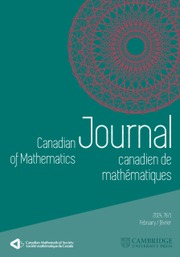No CrossRef data available.
Article contents
Zero-one dual characters of flagged Weyl modules
Published online by Cambridge University Press: 08 July 2025
Abstract
We prove a criterion of when the dual character  $\chi _{D}(x)$ of the flagged Weyl module associated a diagram D in the grid
$\chi _{D}(x)$ of the flagged Weyl module associated a diagram D in the grid  $[n]\times [n]$ is zero-one, that is, the coefficients of monomials in
$[n]\times [n]$ is zero-one, that is, the coefficients of monomials in  $\chi _{D}(x)$ are either 0 or 1. This settles a conjecture proposed by Mészáros–St. Dizier–Tanjaya. Since Schubert polynomials and key polynomials occur as special cases of dual flagged Weyl characters, our approach provides a new and unified proof of known criteria for zero-one Schubert/key polynomials due to Fink–Mészáros–St. Dizier and Hodges–Yong, respectively.
$\chi _{D}(x)$ are either 0 or 1. This settles a conjecture proposed by Mészáros–St. Dizier–Tanjaya. Since Schubert polynomials and key polynomials occur as special cases of dual flagged Weyl characters, our approach provides a new and unified proof of known criteria for zero-one Schubert/key polynomials due to Fink–Mészáros–St. Dizier and Hodges–Yong, respectively.
Information
- Type
- Article
- Information
- Copyright
- © The Author(s), 2025. Published by Cambridge University Press on behalf of Canadian Mathematical Society
References
Armon, S., Assaf, S., Bowling, G., and Ehrhard, H.,
Kohnert’s rule for flagged Schur modules
. J. Algebra 617(2023), 352–381.10.1016/j.jalgebra.2022.10.032CrossRefGoogle Scholar
Assaf, S. and Searles, D.,
Kohnert polynomials
. Exp. Math. 31(2022), no. 1, 93–119.10.1080/10586458.2019.1588180CrossRefGoogle Scholar
Assaf, S. and Searles, D.,
Kohnert tableaux and a lifting of quasi-Schur functions
. J. Combin. Theory Ser. A 156(2018), 85–118.10.1016/j.jcta.2018.01.001CrossRefGoogle Scholar
Brion, M.,
Multiplicity-free subvarieties of flag varieties
. In: Commutative algebra (Grenoble/Lyon, 2001), Contemporary Mathematics, 331, American Mathematical Society, Providence, RI, 2003, pp. 13–23.CrossRefGoogle Scholar
Castillo, F., Cid-Ruiz, Y., Mohammadi, F., and Montaño, J., K-polynomials of multiplicity-free varieties. Preprint, 2022. arXiv:2212.13091.Google Scholar
Eur, C. and Larson, M., K-theoretic positivity for matroids. Preprint, 2023. arXiv:2311.11996.Google Scholar
Fan, N. J. Y. and Guo, P. L.,
Vertices of schubitopes
. J. Combin. Theory Ser. A 177(2021), 105311, 20pp.Google Scholar
Fan, N. J. Y. and Guo, P. L.,
Upper bounds of Schubert polynomials
. Sci. China Math. 65(2022), 1319–1330.10.1007/s11425-020-1843-5CrossRefGoogle Scholar
Fink, A., Mészáros, K., and St, A.,
Dizier, Schubert polynomials as integer point transforms of generalized permutahedra
. Adv. Math. 332(2018), 465–475.10.1016/j.aim.2018.05.028CrossRefGoogle Scholar
Fink, A., Mészáros, K., and St Dizier, A.,
Zero-one Schubert polynomials
. Math. Z. 297(2021), 1023–1042.10.1007/s00209-020-02544-2CrossRefGoogle Scholar
Gao, Y., Hodges, R., and Yong, A.,
Classification of Levi-spherical Schubert varieties
. Selecta Math. (N.S.) 29(2023), Paper No. 55. 40 pp.10.1007/s00029-023-00856-9CrossRefGoogle Scholar
Hamaker, Z., Pechenik, O., and Weigandt, A.,
Gröbner geometry of Schubert polynomials through ice
. Adv. Math. 398(2022), Paper No. 108228. 29 pp.10.1016/j.aim.2022.108228CrossRefGoogle Scholar
Hodges, R. and Yong, A.,
Coxeter combinatorics and spherical Schubert geometry
. J. Lie Theory 32(2022), 447–474.Google Scholar
Hodges, R. and Yong, A.,
Multiplicity-free key polynomials
. Ann. Comb. 27(2023), 387–411.10.1007/s00026-022-00574-7CrossRefGoogle Scholar
Klein, P.,
Diagonal degenerations of matrix Schubert varieties
. Algebraic Combin. 6(2023), 1073–1094.10.5802/alco.296CrossRefGoogle Scholar
Knutson, A., Lam, T., and Speyer, D. E.,
Positroid varieties: Juggling and geometry
. Compositio Math. 149(2013), 1710–1752.10.1112/S0010437X13007240CrossRefGoogle Scholar
Kohnert, A.,
Weintrauben, Polynome, Tableaux
. Bayreuth Math. Schrift. 38(1990), 1–97.Google Scholar
Kraskiewicz, W. and Pragacz, P.,
Foncteurs de Schubert
. C. R. Acad. Sci. Paris Sér. I Math. 304(1987), 209–211.Google Scholar
Kraśkiewicz, W. and Pragacz, P.,
Schubert functors and Schubert polynomials
. Eur. J. Combin. 25(2004), 1327–1344.10.1016/j.ejc.2003.09.016CrossRefGoogle Scholar
Knutson, A., Frobenius splitting and Möbius inversion. Preprint, 2009. arXiv:0902.1930v1.Google Scholar
Knutson, A. and Miller, E.,
Gröbner geometry of Schubert polynomials
. Ann. Math. 161(2005), 1245–1318.10.4007/annals.2005.161.1245CrossRefGoogle Scholar
Magyar, P.,
Schubert polynomials and Bott–Samelson varieties
. Comment. Math. Helv. 73(1998), 603–636.10.1007/s000140050071CrossRefGoogle Scholar
Mészáros, K., Setiabrata, L., and St Dizier, A.,
An orthodontia formula for Grothendieck polynomials
. Trans. Amer. Math. Soc. 375(2022), 1281–1303.Google Scholar
Mészáros, K., Setiabrata, L., and St Dizier, A.,
On the support of Grothendieck polynomials
. Ann. Comb. 29(2025), no. 2, 541–562.10.1007/s00026-024-00712-3CrossRefGoogle Scholar
Mészáros, K., Dizier, A. St., and Tanjaya, A.,
Principal specialization of dual characters of flagged Weyl modules
. Electron. J. Combin. 28(2021), Paper No. 4.17. 12 pp.10.37236/10460CrossRefGoogle Scholar
Mészáros, K. and Tanjaya, A.,
Inclusion-exclusion on Schubert polynomials
. Algebr. Comb. 5(2022), 209–226.Google Scholar
Pechenik, O. and Satriano, M.,
Proof of a conjectured Möbius inversion formula for Grothendieck polynomials
. Selecta Math. (N.S.) 30(2024), Paper No. 83. 8 pp.10.1007/s00029-024-00973-zCrossRefGoogle Scholar
Peng, S. C. Y., Lin, Z., and Sun, S. C. C.,
Upper bounds of dual flagged Weyl characters
. Adv. Appl. Math. 160(2024), 102752, 12pp.10.1016/j.aam.2024.102752CrossRefGoogle Scholar
Postnikov, A., Total positivity, Grassmannians, and networks. Preprint, 2006. http://arxiv.org/abs/math/0609764.Google Scholar


